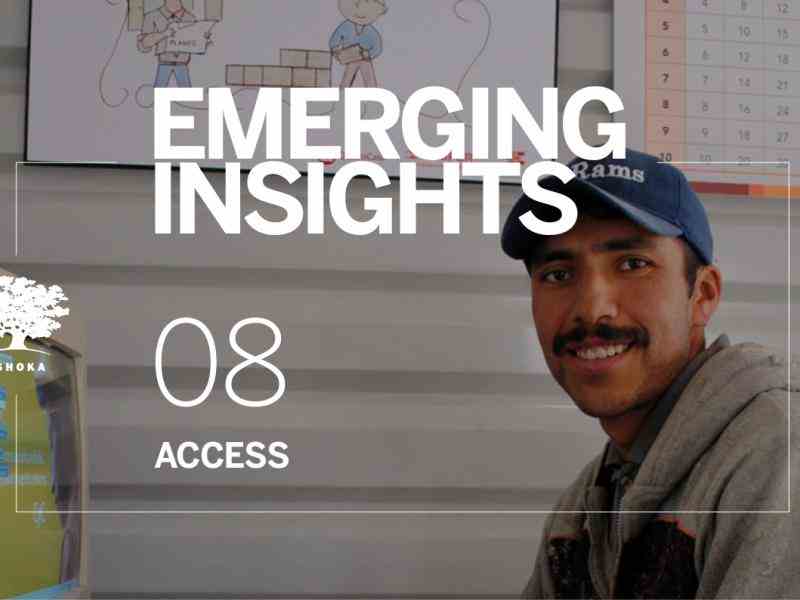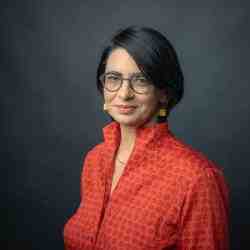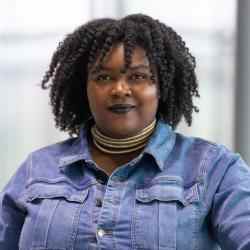Introduction
Through OF/BY/FOR ALL, Nina Simon is building a global movement that challenges the expectations of “public institutions” by helping organizations of all kinds become of, by, and for their communities.
The New Idea
Nina is transforming public institutions such as museums, theaters, parks and libraries from traditional service providers into community-building platforms powered by the people they serve. Based on her experience working in museums across the world, she realized that, with changing demographics, cultural institutions are suffering a relevance crisis, which often leads to insolvency. Through the OF/BY/FOR ALL network, she is building paths for civic and cultural institutions to become representative of, created by and designed for everyone in their communities.
Nina started this work by revamping the Santa Cruz Museum of Arts and History. To bring it back from the brink of bankruptcy she decided she would focus on increasing attendance and participation from underserved communities, in part by co-creating innovative exhibits on social issues designed to spur action for change. One such exhibit was about foster care, co-created by more than 100 current and former foster youth, advocates, and artists. It resulted in visitors becoming volunteer legal advocates, mentoring, and hiring foster youth. By transforming the museum into an institution that is of, by and for the entire Santa Cruz community, it turned into a thriving civic organization with strong finances and sky-rocketing attendance numbers.
With this powerful proof of concept, she is now building an international network of civic institutions to pilot and disseminate new, inclusive growth models for the sector. There are currently 38 member organizations in 9 countries who are beginning to apply the OF/BY/FOR ALL framework within their institutions. In this way Nina hopes to catalyze a wider and more equitable re-shuffling of civic resources to communities.
The Problem
By definition public institutions––be they museums, libraries, parks and other community-serving non-profits––have missions to serve the public (i.e. everyone). Yet they rarely live up to that promise. Despite significant demographic changes, staff, trustees, and participants in civic and cultural organizations remain older, whiter, and wealthier than the general population.
For example, a 2019 Association of Art Museum Directors survey on staff diversity in museums across the U.S. shows that among all museum hires between 2014 and 2018, 88% of people hired for executive and conservation roles were white, even though just 60.7% of the U.S. population identifies as white. That same survey reveals that people of color make up only 11% of staff in leadership positions, though 39.5% of the U.S. population identifies as non-white.
This situation is not unique to museums and the lack of diversity in staffing (and boards) invariably leads to programming that fails to attract the communities public institutions aim to serve. By failing to become relevant to large swaths of the population, they are increasingly struggling to get people in the door, leading in many cases to near bankruptcy or closure.
There are of course many organizations working on increasing equity, diversity, and inclusion (EDI) in public institutions. Dozens of companies focus on capacity building (trainings, fellowships, etc.) but these efforts are often slow, expensive and they tend to be accessed only by large, well-resourced organizations. There is also a growing body of literature on EDI developed by leading academics, journalists and activists but this type of work usually focuses on the “why” and the “what” of this work, not the “how.” While they have done the important work of awakening many public institutions to the moral imperative of inclusiveness, the proven tools and concrete tactics they need are still lacking. Many well-meaning organizations thus end up creating siloed departments of inclusion, diversity, or community engagement. But experience shows that when diversity is seen as a both a moral imperative and a crucial business driver instead of an optional cost center, leaders take more decisive action to integrate it fully into their strategies.
The bottom line is that when institutions systematically exclude people, they consolidate power and access to cultural and civic resources for the few. They could instead become meaningful places for people to share their stories, connect across differences, and build more cohesive communities.
The Strategy
Through her organization OF/BY/FOR ALL, Nina is building a movement of diverse civic organizations working together to build a more inclusive world. In order to achieve this goal, she is building and freely sharing practical tools that help clear the path for organizations to become representative of, created by, and designed for everyone. She is providing hands-on, practical guidance to a Change Network of organizations committed to becoming inclusive.
Nina and her team initially piloted this network in 2018 with a “First Wave” of 21 organizations based in five countries. Each civic institution was carefully selected to ensure a wide range of organizations were represented, proving that the flexible methodology applies across sizes, sectors and geographies. Network members have budgets that range from under $100,000 to more than $5 million. They include museums, libraries, cultural centers, state parks and more; and half of them are led by people of color.
Each organization has assigned 2-6 of their staff members to participate in this network––a signal of their commitment. The tools and guidance provided by the OF/BY/FOR ALL team helps them set goals for community involvement, adopt new behaviors to become of, by and for the communities who most matter to them, and track progress toward their goals.
The first order of business after joining the network is for each organization to make a realistic, quantifiable pledge to engage a specific number of people from a new, underserved community. They then have five months to deliver on that pledge. For example, a library in Minnesota pledged to involve 10 Somali moms in co-creating family programming. A symphony in Oakland pledged to recruit two Latinx professionals for its board of trustees. A park in Belfast pledged to involve 25 young adults suffering with depression in shared stewardship of the park. A museum in Melbourne pledged to involve 500 recently-arrived immigrants in their projects. Collectively, this first wave of the Change Network committed to involving 2,885 new people by March 30, 2019.
Once a particular goal has been set, the OF/BY/FOR ALL team provides ongoing, customized guidance to each organization to ensure they have the highest chances of achieving it. If an organization wants to involve new partners, they’re offering tasks to help them launch those partnerships from a place of mutuality instead of exploitation. If an organization wants to hire people from new communities, they’re offering tasks to help them shift their hiring and HR policies. Twenty of the 21 organizations in the first pilot of the network made major changes to the way they work, recruit, hire, and engage community partners in their first six months. They describe the program as a high-value contributor to organizational growth.
The idea is to use each of these activities as opportunities for Change Network members to learn how to become of, by and for their communities. A foundation upon which they build over time. And time here is critical – Nina knows first-hand that true organizational change takes years to seep in and she is working on ways to ensure each partner commits to this work for multiple years. After a goal is accomplished, organizations are expected to expand their pledge or make a new one. Member organizations can also contribute their own tools and approaches to the Change Network, so the global movement keeps growing based on their diverse learnings and accomplishments.
Participants are tracking their progress using an integrated technology platform developed specifically for the network. This allows OF/BY/FOR ALL to see how these tasks are fueling their work (or not), and also makes it possible for other network organizations to learn from their colleagues. These carefully chosen technologies will help bolster the scalability of the network. Unlike external consultants who usually take on one project at a time, the way the OF/BY/FOR ALL network is set up allows one full time employee to guide the work of roughly 300 people (60 organizations).
OF/BY/FOR ALL’s conservative five-year goal is to help 200 civic and cultural organizations achieve 10% gains in diverse participation––which they estimate would mean one million new people involved in these organizations as leaders, staff, trustees, partners, and participants. Over time, the goal is for network members to start setting up their own community advisory groups, programmatic initiatives, and policy changes. Nina is in the early stages of considering the creation of a global OF/BY/FOR ALL certification akin to LEED or BCorp in order to scale the work in the future.
OF/BY/FOR ALL raised $1,000,000 in 2018 to get started, and they currently have an annual budget of $350,000. Ninety percent of their funds were raised philanthropically from four foundations (including the James Irvine Foundation, the Bush Foundation and the Knight Foundation) and three individuals. The other 10% of their seed funding comes from early experiments in earned revenue from OF/BY/FOR ALL trainings and online courses and the Change Network program. They have developed a pricing structure that gives organizations of different budget sizes, geographic contexts, and leadership structures equitable access to the offerings.
Nina expects OF/BY/FOR ALL to grow to an annual budget of about $1,000,000 in the coming three years. They plan to shift from reliance on philanthropy to earned income over time. This earned income strategy is buttressed on the belief that when organizations invest financially, it demonstrates their commitment to change.
The Person
Nina Simon identifies as a space-maker. From a young age, she was driven to open up new spaces for herself and others. She was the first girl on the water polo team and the boxing club, and eventually, one of a tiny number of female university students studying electrical engineering. She also helped start her junior high’s gay straight alliance and advocated for women in engineering. She always felt that these spaces should live up to their promises to be “for everyone.” When she saw that they weren’t, she worked to open them up.
Upon graduating as an electrical engineer, Nina landed her dream job at NASA. A few months into her new career, she left that job. Though at the time she thought she was leaving NASA to find a better fit, Nina now knows that she was tired of never fully belonging in the spaces she had chosen. Though she gave up on her childhood dream of sending people into space, leaving NASA also gave her a new dream: to design and build institutions where everyone felt like they belonged.
Nina started by working in museums to create projects that invited community members to create exhibitions and programs with professionals. At the time, the idea of participatory museum exhibits was unprecedented. She started writing a blog called Museum 2.0 and quickly became a sought-after thought leader and museum practitioner. Prestigious museums from around the world hired her as a consultant to help modernize their institutions. Though it was fulfilling work and quite lucrative, Nina wanted to move from a teaching role to doing the actual community-based work.
She became the director of the Santa Cruz Museum of Art & History (MAH) in 2011. What she inherited was an institution on the verge of bankruptcy that attracted only about 17,000 visitors a year. In essence, too few people were interested in the programming to show up. Nina realized that she would either have to close down the museum or start becoming relevant to the community that hosted it. They re-evaluated their mission and decided to turn away from being a traditional museum towards doing community-centered work. The new vision was now to use art and history to build a stronger, more connected community. Over the course of seven years, they transformed a dying museum into a vibrant community center, growing attendance nine-fold, building 40 times more partnerships with the community and growing the original $16,000 in the bank to $5 million. Annual attendance increased from 17,000 to 148,000 – and those 148,000 people reflected the full diversity of the community. They showed that diversity and dollars can go together. That they both contribute to successful, relevant, and resilient institutions and communities.
Equally important was the realization that spacemaking is a form of allyship. While Nina’s work with museums was always focused on increasing participation from audiences, her work at MAH demonstrated that, when participatory practices are paired with inclusiveness, public institutions can finally live up to the promise of generously sharing civic and cultural resources with everyone.
In her time as director of the MAH, Nina always made sure she shared what they learned with transparency and humility in the hopes that others would be inspired by the changes they had implemented as a community. She wrote two best-selling books and gave hundreds of lectures and keynotes. When people started to take notice and apply some of her lessons learned to their organizations in ad hoc ways she realized she had to start systematizing her work and sharing it more widely. Thus, OF/BY/FOR ALL was born.

 Tile image
Tile image

